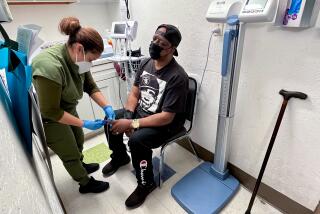Oakland clinic gets medical device maker to disclose risk of false blood-oxygen reading

- Share via
- An Oakland clinic’s lawsuit is helping to change that in California.
The pulse oximeter, a device that measures the degree to which red blood cells are saturated with oxygen, is one of healthcare’s most fundamental tools.
So when Dr. Noha Aboelata learned that research stretching back decades showed that the devices routinely failed patients with darker skin tones, she took action.
Aboelata, the founder and chief executive of East Oakland’s Roots Community Health Center, urged the Food and Drug Administration to require makers of pulse oximeters to test their devices on people of color, and to warn consumers about the risk of false readings.
Attorneys for Roots wrote to companies that made or sold pulse oximeters in California, asking them to improve their products and disclose their limitations. When none responded, the clinic filed a lawsuit to force a change in practices.
A year later, Roots and Aboelata are celebrating their first wins.
Minneapolis-based Medtronic, a leading provider of the devices to hospitals, reached a settlement with Roots last month.
Medtronic agreed to provide brochures and advisory labels on pulse oximeters sold to California hospitals, informing users that the devices can artificially inflate blood oxygen estimates on patients with darker skin. In exchange, Roots dropped its claims against the company.
In a statement, Medtronic said it “looks forward to working with Roots, the FDA and other key stakeholders to ensure health equity can be achieved through technology, educational efforts, and partnerships.”
Three other companies that sell directly to consumers also agreed to place informational labels on their products.
The suit is proceeding against CVS, Walgreens, GE HealthCare and five other defendants that have not settled, Roots attorney Jonathan Weissglass said.
CVS and GE said they wouldn’t comment on pending legislation. Walgreens didn’t immediately respond for comment, but said earlier this year that it also would not comment on pending litigation.
The settlements are a step toward resolution for a pervasive yet frequently overlooked problem that has haunted medicine for decades.
“This pulse ox issue should never have been allowed to happen, and once it was known, it should not have been allowed to continue,” Aboelata said. “I’m still talking to people every week who don’t know about it.”
A pulse oximeter shines a light that passes through the patient’s skin, blood and tissues, and then measures how much light comes out the other side. They’re typically clipped on a fingertip.
Before pulse oximeters were widely adopted in the 1980s, the only way to gauge a patient’s blood oxygen saturation was to draw blood from their arterial vein, a painful procedure that had to be followed by immediate laboratory analysis.
Oxygen-rich blood absorbs more infrared light. So does melanin, the pigment that helps determine skin, hair and eye color. As a result, patients with darker skin tones are more likely to get pulse oximeter readings that show their blood oxygen saturation to be higher than it actually is.
As early as 1990, researchers noted that Black patients were more likely to get deceptively high “pulse ox” readings when hypoxic, or suffering from low oxygen.
In 2005, UC San Francisco’s Hypoxia Research Laboratory found the devices were more likely to overestimate oxygen saturation in patients with dark skin than in those with light skin, results the lab confirmed in a follow-up study two years later.
Yet many providers — including those like Aboelata, who focused on addressing racial inequities in healthcare — were unaware of this data. This became a matter of life and death during the COVID-19 pandemic, when pulse oximeter readings became the primary metric hospitals used to determine who should get care.
CDC guidelines instructed providers to start anyone with pulse ox readings below 90% on oxygen therapy.
A 2020 study of thousands of patients at the University of Michigan found that Black patients, compared with white patients, had nearly three times the rate of “occult hypoxia” — low blood oxygen that goes undetected because pulse oximeter readings are in the normal range.
After reading the study, a pharmacist and cardiologist from the University of Michigan looked at 204 patient records from their hospital.
In a study published in February, they found that Black patients’ blood oxygen readings on pulse oximeters were on average 6% higher than the actual blood oxygen levels measured in their arterial blood samples. In contrast, pulse oximeters overestimated white patients’ blood oxygen by just 1% on average.
Artificially high blood oxygen readings could lead physicians to underestimate how much blood is pumping from a patient’s heart or overestimate the degree of resistance in the patient’s vascular system, the researchers said.
“Those sorts of measurements can impact how we care for patients with heart failure, and can impact their candidacy for more intense treatment options like heart transplants and heart pumps,” cardiologist Dr. Scott Ketcham said.
Currently, the FDA recommends — but doesn’t require — that pulse oximeter makers ensure that in their clinical trials, either two participants or 15% of total participants are “darkly pigmented” people, a definition open to interpretation.
In February 2021, the FDA issued a safety notice cautioning users that pulse oximeters can be thrown off by a number of variables, including skin pigment.
In February, an agency advisory panel recommended that the FDA require that new devices be tested on at least 24 people whose skin tones collectively span the Monk Skin Tone scale, a 10-color palette often used to train artificial intelligences to recognize people of different colors.
The proposal would divide the scale into three parts, with each part represented by at least 25% of study participants.
Though the FDA indicated that it would issue new guidelines for pulse oximeter manufacturers by Sept. 30, it has not done so yet. The agency is working to release the updated guidance “as expeditiously as possible,” a spokesperson said.
The FDA also funded a study at UCSF’s Hypoxia Research Laboratory to better understand the relationship between skin pigment and pulse ox accuracy. The research team is preparing its results for publication now, said Dr. Phil Bickler, director of the UCSF lab and an investigator on the study.
Until then, making sure their devices work equally well for users of all skin tones is optional for manufacturers.
When Manhattan Beach-based BodiMetrics, a maker of wearable health monitors, sought FDA clearance for its most recent smart ring fitness tracker, the company opted to broaden the range of skin tones represented in its study population. One-third of its study population had darker skin pigment, compared with the FDA-recommended minimum of 15%.
“It’s a lot more money to do the clinical studies [to] prove that we didn’t have a pigmentation problem,” BodiMetrics founder and chief operating officer Neil Friedman said. “But that was our goal ... to make sure that people had a device that properly measured their blood oximetry and prevented them from being misdiagnosed or potentially dying.”







